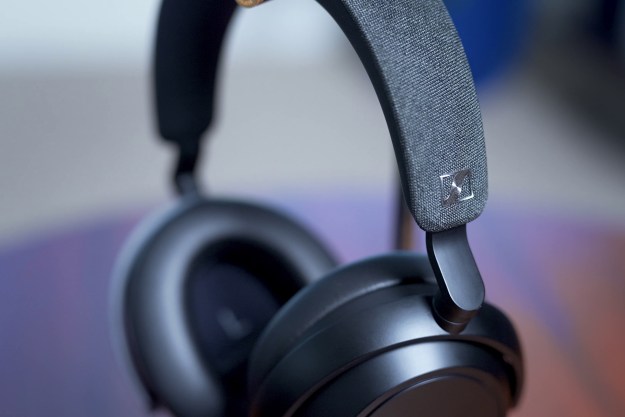“The Sennheiser PC160s are an all-around excellent option for anyone that wants an inexpensive, high quality hybrid headset.”
- Integrated microphone; comfortable for extended use; in-line volume control
- Weak bass; small ear pads
Summary
There are a number of gaming headphone options with integrated microphones. So, what happens when a high end, audiophile headphone manufacturer throws their best into the ring? The Sennheiser PC160, while exhibiting the same build quality we’ve come to love from Sennheiser, was slightly lacking in sound quality, but a good overall performer.
Features and Design
There are two classes of gaming headphones: Those with and without an integrated microphone. Without a microphone, the makers are basically marketing the bass response, relatively low cost, and eccentric plastics. With the explosion of online gaming over the past five years, especially MMORPGs, there has been a parallel explosion in gaming headsets with microphones. The idea really took off with online console gaming, with Xbox Live and SOCOM for the PS2, since users had a limited number of buttons and no keyboard with which to communicate in a traditional manner. Add to that the ubiquity of broadband gaming, and the availability of more bandwidth for the voice data, and you have a flourishing market thirsty for new equipment.
Sennheiser is one of our favorite headphone manufacturers. The legendary sound quality and the appeal to audiophiles in nearly everything they produce make Sennheiser a super power in the headphone world. The PC160s are the flagship gaming headphone, making them of particular interest to us. There is a PC160SK, which has the same innards but a stylized casing, and a PC165, which includes an adapter to use with a PC USB port.
The package contents are slim and straightforward. You get the headphones with a non-removable microphone, and that’s it. Rather than play games with USB sound card drivers and “surround sound” abilities, the PC160s sports two standard 1/8″ plugs: One for sound in and out. The two cords are fused together for most of the length, with four inches at the plug end split. The point where the two plugs split has a piece to prevent further separation of the two cords. The headset’s cord measures an ample nine feet and enters through the left earpiece. There is also an inline volume control and microphone mute button three feet from the headphone end.
All this extra weight on the left earpiece does not make the headphones feel lopsided. Overall, the fit is snug, but not too snug. Each earpiece adjusts independently, and the microphone swivels up and out of the way for regular listening. The ear pads are covered with a soft velour that won’t trap heat and can easily be worn for hours. The open air design ensures that the outside world is still audible. We were annoyed by the small earpiece size, which rests on the outside instead of around the ears. Usually, the raised puffy surrounding padding fits around the ear, resting on the head. With the PC160s, the padding rests on the ear itself. The microphone features built-in noise canceling technology and can be flexed along the stalk. There is an optional windscreen piece that reduces pops and wind noise while speaking.
Image Courtesy of Sennheiser
Performance
We tested the PC160s with both communications during games, in addition to our usual battery of headphone tests. Also, an audio segment as well as an entire episode of the Digital Trends Podcast were recorded for analysis, so you can judge the microphone quality for yourself! On the microphone end, sound quality was exceptional. There was little to no hiss at modest gain settings, and sound was natural and warm. We’re used to hearing tinny and poorly controlled volume from similarly priced gaming headsets. In subjective analysis, asking several groups of gamers to rate the audio quality from one to ten over TeamSpeak 2, the PC160s were rated a nine on average. This was in line with our recorded clip compared to the high-end Shure 55SH microphone. While this is an unfair comparison, the PC160s did have excellent sound clarity in comparison if the price and market are factored in.
The big surprise for us was the sound quality from the headphones. While not poor, we’ve come to expect better from Sennheiser. Strangely, compared to other Sennheiser
On the gaming side, the same tight, accurate bass worked against the PC160s. Sound localization and quality were excellent, but explosions and special effects just didn’t have the percussive power we would have liked. We played Quake 4, Half Life 2, and City of Villains, and found that while bullets ricocheting and footsteps were atmospherically accurate, rockets and large blasts just didn’t jar us as much as we would have liked. City of Villains fared better than HL2 and Q4, since there are fewer bass-heavy explosions. The 3D processing actually slightly got in the way. The soundstage surrounds the listener, but is slightly weak in the front, causing objects and enemies directly in front of us to sound as if they were instantly transported to one side with the slightest movement.
Conclusion
The Sennheiser PC160s are an all-around excellent option for anyone that wants an inexpensive, high quality hybrid headset. Sennheiser fans will want to take note of the distinctly different acoustic signature, but most users will find it very enjoyable. Gaming is not the strong point of the PC160s, which is a pity, since that is the intended market. The 3D processing throws off sound localization, and the tight bass leaves us asking, “Was that a stale pack of Pop Rocks, or machine gun fire?”
Pros:
- Integrated microphone
- Comfortable for extended use
- Inline volume control
Cons:
- Weak bass
- Small ear pads
Editors' Recommendations
- Best headphone deals: AirPods, Sony, Sennheiser and more
- Sennheiser Accentum Plus aims at the middle ground between budget and baller
- The best Dolby Atmos soundbars for 2023
- Sennheiser’s Ambeo Soundbar Mini is a pricey, bedroom-sized Dolby Atmos speaker
- Updating our Sony WF-1000XM5 review





